constraint theory
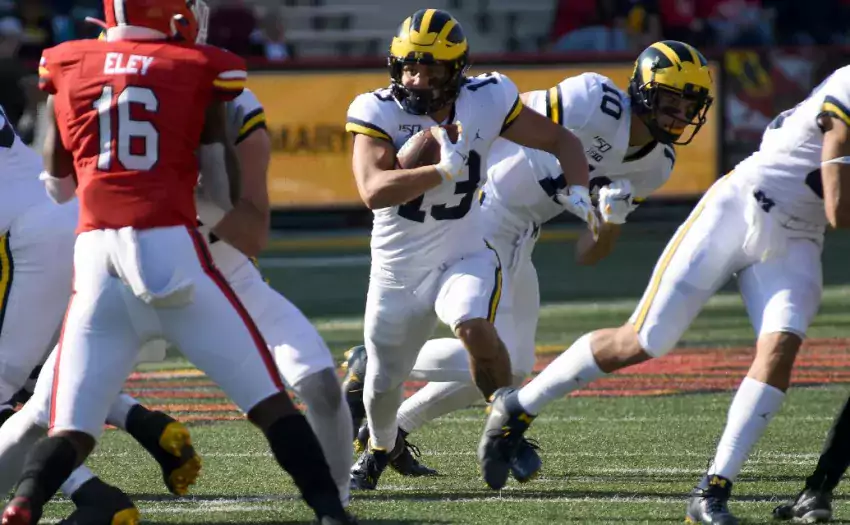
I know Brian and many of my other peers are against this, but I like the "Truuuuuuu!" cheer. Sure it's simple, and not at all unique—I learned it as a kid as "Louuuuuuuu" when Whitaker came to bat. But simple cheers are also those that can get a high level of participation, which is key to unlocking one of my favorite fandom achievements in sports: The audible road takeover:
Let's see how we got here:
The Backside of Power
After putzing around doing a ton of things in the first few games, Michigan used Rutgers to simplify, going back to the Arc/Split Zone and Pin & Pull base we've been talking about since Warinner installed it last year. Since then they've been thickening these parts of the playbook.
When you can concentrate on a base running play you can do more than just open up counters to it. You can start building on-the-fly adjustments into the play itself to torture opponents who practiced for it, see it, react to it in a way that should be advantageous for them, and then get put to the wrong side.
We got a great example of this from Michigan's Power-O running game against Rutgers 2017. This was the third year under Harbaugh and Drevno, who made this their base running play at San Diego, then Stanford and San Francisco. Rutgers thought they could attack this by slanting the defensive line to playside all the time, screwing up all the intended downblocks and delivering a meaty tackle into the intended gap:
Here's an example of this—just with the RT and the LG switching jobs. The guy you're paying attention to is the backside tackle, who ruins this play despite Juwan Bushell-Beatty ejecting the tackle on the playside.
So Harbaugh/Drevno figured out a way to punish this behavior. In the second half Michigan was zone blocking that backside DT instead of blocking down on him. If he tried to slant towards the power gap, center Mason Cole let him, sealed him there, and laughed as the cable subscribers got gashed with cuts behind that.
So how how is this relevant to 2019 Maryland? Well Harbaugh/Gattis are now doing the same thing with Pin & Pull.
[After the JUMP: Backdoors]
"Every football team eventually arrives at a lead play: a "Number 1" play, a "bread and butter" play. It is the play that the team knows it must make go, and the one its opponents know they must stop. Continued success with it, of course, makes your Number 1 play, because from that success stems your own team's confidence." –Vince Lombardi
As we discuss coaching candidates we'll invariably get into the same old discussions on what kind of base offense said candidate might want to run. There was some discussion on the board this week and I wanted to expand that discussion into some basic "Rock" plays of various offensive schemes.
It is incorrect to identify any one play (and even more incorrect to identify a specific formation or personnel group) as a complete offense. You always need counters to keep doing the thing you do, and the counters will often borrow directly from some other offensive concept's rock. All offenses will borrow from each other so no breakdown is going to describe more than 60% of any given offense. Most zone blocking offenses throw in man-blocked things (example: inverted veer) to screw with the defense. You can run most of these out of lots of different formations. You can package counters into almost all of them (example: The Borges's Manbubble added a bubble screen to inside manball).
Really what you're describing when you talk about any offense is the thing they do so well that they can do it for 5 or 6 YPP all day long unless defenses do something unsound to stop it (like play man-to-man, or blitz guys out of coverage, etc.). Some examples of offenses and their formation needs (where a need isn't specified, figure they can use any set or formation: spread, tight, 23, ace whatever). I've given the rock plays, and left out the counters and counters to the counters because that gets into way too many variants.
Finally, the terms "pro style" and "spread" are meaningless distinctions. NFL offenses have the luxury of getting super complex: they have passing game coordinators who teach the QBs and WRs Air Raid things then run zone or power blocked things. The spread refers to formations and personnel—it doesn't say anything about whether the QB runs, if it's an option offense, or what tempo it runs at, or even what kind of blocking it uses. What I've done here is break up the offenses into "QB as Run Threat" and "QB Doesn't Have to Run" since the construction of these base plays usually stems from that. Remember, however, that QB running offenses can (and often do) still use blocking right out of Vince Lombardi's favorite play.
QB as Run Threat Offenses:
Triple Option
The FB dive will hit too quickly for anyone but the DE to stop; once the DE bites, the RG moves down to the second level while the QB keeps and heads outside, with the RB in a pitch relationship to defeat the unblocked defender there.
Concept: QB makes a hand-off read then a pitch read.
Makes life especially hard on: Edge defenders who have to string out plays against multiple blockers and maintain discipline.
Formation needs: Two backs.
Helpful skills: QB who can consistently make multiple reads and won't fumble, highly experienced, agile OL, backs who can both run and bock.
Mortal enemy: The Steel Curtain. Stopping the triple option is a team effort; if everybody is capable of defeating blocks, challenging ball-carriers, and swarming to the pitch man there's nowhere to attack.
Examples: Air Force, Nevada, Georgia Tech, Bo's Michigan
[Hit the jump for ZR, QB power, Air Raid, West Coast, Manball, Inside Zone, and the Power Sweep].
FORMATION NOTES: Not a whole lot that was unusual. Michigan has changed the alignment of their backs in some shotgun sets:
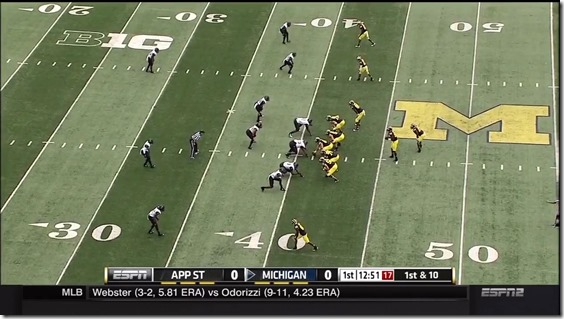
I called this "shotgun deep" since the QB is still at 5 yards but the back is behind instead of parallel. I imagine they did this for the same reason the pistol exists: to give the back downhill momentum when he takes a handoff.
Conventional shotgun sets were frequent as well, as were split TEs. This is the first snap of the game and features Hill motioning from an H-back spot to the slot; he'll block for Funchess on a successful flanker screen.
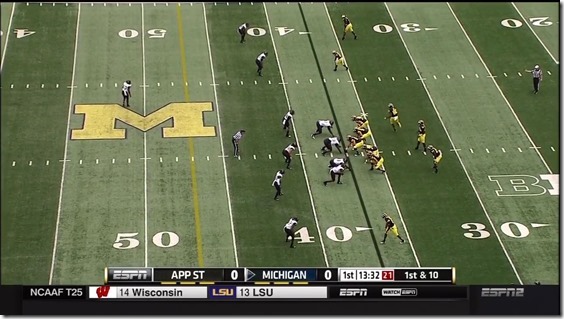
Michigan would occasionally scrape up an I-Form out of whatever was laying around, like when Chesson motioned in here. This actually cut behind Chesson's force block to pick up 15.

SUBSTITUTION NOTES: OL was Cole-Magnuson-Miller-Burzynski/Kalis-Braden the whole way. Gardner obviously QB until garbage time; he got pulled a couple drives before Michigan did much non-WR substitution.
Feature backs were Green and Smith with Hayes apparently a third down option; Drake Johnson only saw garbage carries and should no longer be considered a playing time contender going forward.
At WR it was Funchess, Chesson, Darboh, and Norfleet rotating approximately equally; Canteen did not get on until late. Bo Dever is your backup slot, apparently. Tight end was mostly Hill and Williams with a bit less Heitzman sprinkled in.
[After THE JUMP: all things discussed.]
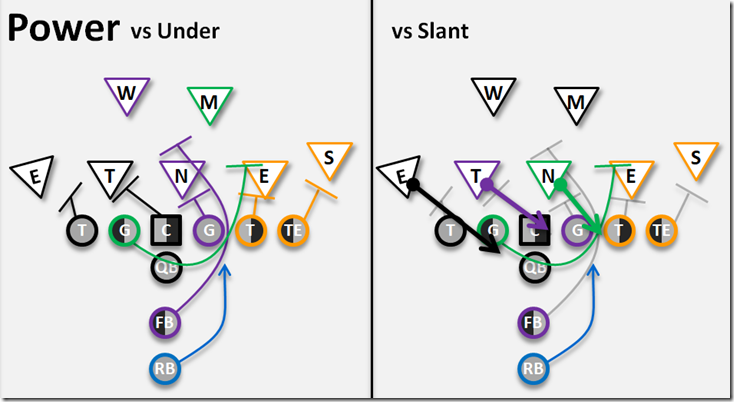
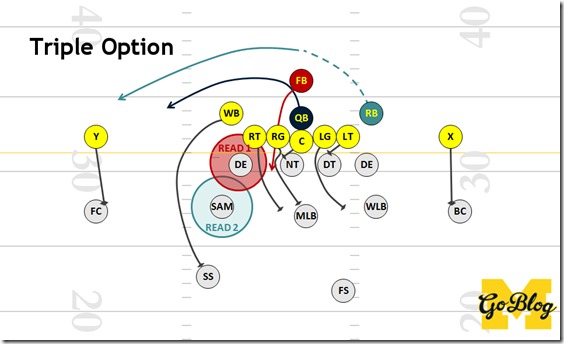
11